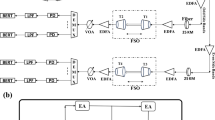Abstract
Optical switching networks (OSN) rely on both hardware components and signals for performing efficient switching operations achieving service level requirements of the end-user. In this manuscript, an incremental learning-based wavelength assignment is introduced to minimize asynchronous channel selection and dispersion-free switch-over in OSN. This method accounts on the wavelength dispersion characteristics of the light path for establishing and reconnecting communications between end-to-end devices. The learning process segregates favorable and conflict channels based on blocking probability and channel capacity assigned to the optical users. A conventional wavelength division multiplexing technique is employed for improving data transmission rates. This method is appropriate for evading blocking rates in optical networks to improve throughput rate and to leverage OSN performance. Machine learning (ML) paradigm is designed for OSN leverages the communication rate influenced by channel conflicts and utilization capacity. Therefore, the number of transmissions likely requires optimal switch-over with the knowledge of channel constraints to improve the performance of OSN.









Similar content being viewed by others
References
F.S. Abkenar, A.G. Rahbar, A. Ebrahimzadeh, Providing quality of service (QoS) for data traffic in elastic optical networks (EONs). Arab. J. Sci. Eng. 41(3), 797–806 (2015)
S. Ahsan, C. Browning, M.S. Wang, K. Bergman, D.C. Kilper, L.P. Barry, Excursion-free dynamic wavelength switching in amplified optical networks. J. Opt. Commun. Netw. 7(9), 898 (2015)
M. Asghari, A.G. Rahbar, Contentionless transmission in buffer-less slotted optical packet switched networks. Opt. Fiber Technol. 30, 134–146 (2016)
M. Asghari, J. Bagherzadeh, S. Yousefi, Loss estimation and control mechanism in bufferless optical packet-switched networks based on multilayer perceptron. Photonic Netw. Commun. 35(2), 274–286 (2017)
S. Baskar, S. Periyanayagi, P.M. Shakeel, V.S. Dhulipala, An energy persistent range-dependent regulated transmission communication model for vehicular network applications. Comput. Netw. (2019). https://doi.org/10.1016/j.comnet.2019.01.027
H. Bayrampour, R. Sabbaghi-Nadooshan, Optimization of quantum networks using novel non-blocking optical switches. Opt. Switch. Netw. 22, 69–76 (2016)
G. Danilewicz, W. Kabaciński, R. Rajewski, Strict-sense nonblocking space-wavelength-space switching fabrics for elastic optical network nodes. J. Opt. Commun. Netw. 8(10), 745 (2016)
M. Fayyaz, K. Aziz, G. Mujtaba, Blocking probability in optical interconnects in data center networks. Photonic Netw. Commun. 30(2), 204–222 (2015)
L. Gao, Y. Li, G. Shen, Lightpath blocking performance analytical model for a single ROADM node with intra-node add/drop contention, in 2014 IEEE/CIC International Conference on Communications in China (ICCC) (2014)
W. Gao, M. Cvijetic, Allocation of spectral and spatial modes in multidimensional metro-access optical networks. Opt. Commun. 413, 80–86 (2018)
Y. Hong, X. Hong, S. He, J. Chen, Hybrid routing and adaptive spectrum allocation for flex-grid optical interconnects. J. Opt. Commun. Netw. 10(5), 506 (2018)
M. Imran, M. Collier, P. Landais, K. Katrinis, Performance evaluation of hybrid optical switch architecture for data center networks. Opt. Switch. Netw. 21, 1–15 (2016)
C. Jatoba-Neto, D.A.A. Mello, C.E. Rothenberg, S.Ö. Arik, J.M. Kahn, Scaling SDM optical networks using full-spectrum spatial switching. J. Opt. Commun. Netw. 10(12), 991 (2018)
Y. Ji, J. Zhang, X. Wang, H. Yu, Towards converged, collaborative and co-automatic (3C) optical networks. Sci. China Inf. Sci. 61(12), 121301 (2018)
W. Mo, C.L. Gutterman, Y. Li, S. Zhu, G. Zussman, D.C. Kilper, Deep-neural-network-based wavelength selection and switching in ROADM systems. J. Opt. Commun. Netw. 10(10), 1–11 (2018)
A. Őzmen, H. Şenol, Channel estimation for realistic indoor optical wireless communication in ACO-OFDM systems. Wirel. Pers. Commun. 102(1), 247–259 (2018)
P. Pavarangkoon, E. Oki, A routing and wavelength assignment scheme considering full optical carrier replication in multi-carrier-distributed optical mesh networks with wavelength reuse. Opt. Switch. Netw. 28, 23–35 (2018)
S.K.S.L. Preeth, R. Dhanalakshmi, R. Kumar, P.M. Shakeel, An adaptive fuzzy rule based energy efficient clustering and immune-inspired routing protocol for WSN-assisted IoT system. J. Ambient Intell. Humaniz. Comput. (2018). https://doi.org/10.1007/s12652-018-1154-z
P. Qin, J. Wu, X. Li, Y. Tang, Multipoint to multipoint routing and wavelength assignment in multi-domain optical networks. Physica A 490, 1454–1460 (2018)
R. Rumipamba-Zambrano, J. Perelló, J.M. Gené, S. Spadaro, Cost-effective spatial super-channel allocation in flex-grid/MCF optical core networks. Opt. Switch. Netw. 27, 93–101 (2018)
J. Song, K.-E. Han, D.-U. Kim, C. Park, K. Kim, Priority-based grant-aware scheduling for low-latency switching. Photonic Netw. Commun. 36(2), 175–186 (2018)
N.L. Venkataraman, R. Kumar, P.M. Shakeel, Ant lion optimized bufferless routing in the design of low power application specific network on chip. Circuits Syst. Signal Process. (2019). https://doi.org/10.1007/s00034-019-01065-6
L. Wang, X. Wang, M. Tornatore, K.J. Kim, S.M. Kim, D.-U. Kim, K.-E. Han, B. Mukherjee, Scheduling with machine-learning-based flow detection for packet-switched optical data center networks. J. Opt. Commun. Netw. 10(4), 365 (2018)
D. Xie, D. Wang, M. Zhang, Z. Liu, Q. You, Q. Yang, S. Yu, LCoS-based wavelength-selective switch for future finer-grid elastic optical networks capable of all-optical wavelength conversion. IEEE Photonics J. 9(2), 1–12 (2017)
Z. Zhang, W. Hu, W. Sun, L. Zhao, K. Zhang, Elastic optical ring with flexible spectrum ROADMs: an optical switching architecture for future data center networks. Opt. Switch. Netw. 19, 1–9 (2016)
F. Zhou, M. Ju, A. Ait-Ouahmed, Joint optimization for multicast provisioning in mixed-line-rate optical networks with a column generation approach. J. Lightwave Technol. 36(3), 637–649 (2018)
Acknowledgements
The authors extend their appreciation to the Deanship of Scientific Research at King Saud University for funding this work through research group No. (RG-1439-053).
Author information
Authors and Affiliations
Corresponding author
Additional information
Publisher's Note
Springer Nature remains neutral with regard to jurisdictional claims in published maps and institutional affiliations.
Rights and permissions
About this article
Cite this article
AlZubi, A.A., Alarifi, A. & Alnumay, W. Machine Learning-Based Channel Analysis for User Concentric Optical Switching Networks. Circuits Syst Signal Process 39, 1178–1194 (2020). https://doi.org/10.1007/s00034-019-01165-3
Received:
Revised:
Accepted:
Published:
Issue Date:
DOI: https://doi.org/10.1007/s00034-019-01165-3




